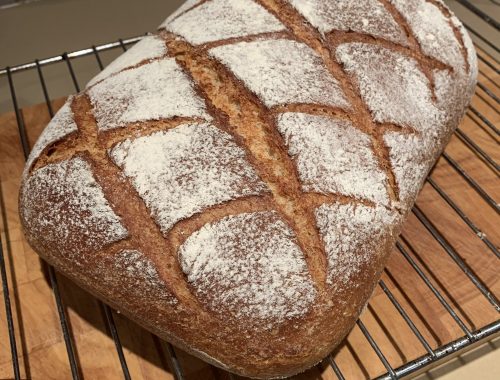
Malted Bagels… or Beigels?
Today’s baking adventure is the tasty, chewy bagel, or is it Beigel? Growing up we often had a special occasion treat of Beigels with Jewish Deli. I think that I will try to stick with Beigel today, because that how it was always said by my family back then. They were always proper Beigels from a Jewish Bakery in Barkingside or Gants Hill; small, chewy on the outside, soft on the inside. Accompanied by cream cheese, smoked salmon, chopped herring, roll mops, gherkins, Fish balls, Schmaltz Herring, Potato Latkes, occasionally even Salt Beef.
All of the Supermarkets do “Bagels” but none of them are a patch on the Jewish Bakeries’ Beigels. The mass produced version is just a soft, bready, roll with a hole in the middle. Seeking out good Beigels is always worth the effort. When we lived in North London I found that you could get pretty decent ones from “The Happening Bagel Bakery” in Finsbury park, alternatively it would be a trip to Brick Lane or Golders Green to get the good stuff. Only the Jewish bakeries seem to know the secret to doing them right. Down here in Coulsdon there’s nothing to be had apart from the bready, boring supermarket efforts.
I have made Beigels quite a few times in the past, the process is different from making normal bread but definitely worth having a go at. Traditionally they are made with white flour, but I decided that malted Granary Flour could be a tasty alternative. Something that I learned this week is that “Granary Flour” is actually a trademark of Hovis, so you only get Hovis Granary Flour. Other companies do their own versions under different names – I have a bag of Allinson’s Country Grain Bread flour in the cupboard, which is essentially the same stuff.
When I make a loaf with malted flour, I only use the one type of flour. It makes a lovely crusty loaf that has soft crumbly texture, which makes excellent toast. My gut was telling me that on this occasion the texture might not turn out right for Beigels. I wanted the sweet, malty flavour of the Granary flour, but also the close, chewy texture of a traditional Beigel. In the end I went for a 50/50 mix with strong white flour. I think that this was the right way to go, the results were amazing! I also went with a spoonful of brown sugar in the mix and some Caraway Seeds for extra flavour.
What makes this Beigel Baking different from other bread baking is that the dough does not get a second prove. Instead, the shaped dough gets a brief bath in boiling (slightly sugary) water. This puffs up the dough and helps to give them the shiny, chewy crust and soft but dense inside that I expect of a proper Beigel. Getting the traditional ring shape is a bit of an art. I have seen various ways of doing it online and have found that my preferred method is to make buns shapes and then poke a floured wooden spoon handle through the middle, then give it a spin to open out the hole. This way there are no joins, and you should end up with a nice smooth surface.
Malted Beigels
250g Malted Grain Bread Flour
250g Strong White Bread Flour
2 tsp Dried Yeast
1 tbsp Brown Sugar
2 tsp Salt
2 tsp Caraway Seeds
300ml Warm Water
4 tbsp granulated Sugar
- Mix together the flours, yeast, brown sugar, salt and caraway seeds in the bowl of a stand mixer, or a large mixing bowl.
- Attach a dough hook and set the mixer going, gradually adding in the warm water, mixing until the dough comes together. Knead with the dough hook for 10 minutes, or by hand for 15 minutes. The dough should be smooth and elastic, soft but not sticky.
- Place the ball of dough in a large, oiled bowl and cover with cling film. Leave in a warm place to prove for around 60 to 90 minutes until doubled in size.
- Pre-heat the oven to 200°c (Fan).
- Remove the dough from the bowl and knead briefly to knock out any air bubbles. Divide into 8 equal sized pieces and then shape into slightly flattened balls by rolling the dough around between the palm of your hand and the work surface. Let the shaped balls rest for a few minutes before proceeding with making the holes.
- Dust the work surface liberally with flour and dip the handle of a wooden spoon in flour. Poke the spoon handle through the centre of each ball and then spin the dough around the handle to widen out the hole. You are looking for holes that are around 3cm. As you make each Beigel ring, cover them up loosely with cling film whilst you continue shaping the others.
- Bring a big pan of water to the boil and mix in the granulated sugar. Keep the pan on a rolling boil. Drop in two or three beigels at a time, they will quickly rise to the surface. Boil for one minute, flip them over and boil for one more minute, then gently remove to a rack with a slotted spoon. They will look a bit wrinkly at this stage but will puff up a bit more in the oven and iron out the wrinkles.
- At this point you could sprinkle them with poppy or sesame seeds. Place on a large tray lined with baking paper and bake for 25 minutes until browned. Keep an eye on them and rotate the tray so that they brown evenly. Like any bread, when they are done they should sound hollow when tapped on the bottom. Remove to a rack to cool.















